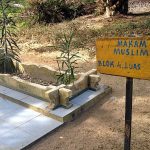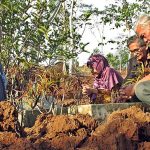Commemoration of the “Orba” Prison in Tangerang*
![YPKP 65: Chairperson of YPKP 65, Bedjo Untung, explained to his guest during the Napak Tilas Prison field visit and the 1965 Political Prisoners Concentration Camp in Tangerang Photo Credit: YPKP'65 [hum]](http://ypkp1965.org/wp-content/uploads/2019/09/20190905_100830_9-bu-guangju-ypkp-655x360.jpg)
The years between 1965-1979 were the bleakest times in Indonesia, especially in the political and humanitarian fields. Hunting, arrest, imprisonment, kidnapping, rape of women, seizure of property and slaughter of people; afflict many people who are active in the movement. And it is widespread everywhere.
Large-scale hunting and arrest of the people without due process of law becomes a common picture that occurs in a “Pancasila country” that should respect human values. But precisely this irony is so real. A wave of imprisonment of people, other than those killed for alleged political manipulation, has led to a surge in political prisoners (Tapol_Red) throughout Indonesia.
One of the prisoners’ detention centers is the Special Detention Center (RTC), which is more popularly known as “Tangerang prison” which is known for its violent labor practices. At that time, this prison had to accommodate an abundance of political prisoners from the Salemba prison in Jakarta. No less than 6,000 political prisoners are incarcerated in that prison.
The Tangerang RTC was a youth prison from the beginning it was built by the Dutch East Indies colonial government in 1927. This building was better known as the Jeugd Gevangenis of that era, whose function was none other than a prison for Dutch and Indigenous youths .
![YPKP 65: Chairperson of YPKP 65, Bedjo Untung, explained to his guest during the Napak Tilas Prison field visit and the 1965 Political Prisoners Concentration Camp in Tangerang [hum]](http://ypkp1965.org/wp-content/uploads/2019/09/9742-bu-lie-300x195.jpg)
YPKP 65: Chairperson of YPKP 65, Bedjo Untung, explained to his guest during the Napak Tilas Prison field visit and the 1965 Political Prisoners Concentration Camp in Tangerang [hum]
This wide stretching zone is indeed bounded by the Cisadane river which never dries its water, flows from upstream in the Bogor area and empties into the Java Sea. A portion of this vast land was the result of the military seizing land belonging to Chinese families who were accused of being communists. Several military installations, including the Kodim (Military District Commander) headquarters, are in the area which from 1965 until now has been an asset of the Indonesian Ministry of Law and Human Rights.
What is the condition and life of the prisoners in prison who are known for their cruelty inside and the practice of forced labor outside?
Like most other prisons in Indonesia , prisoners in Tangerang prisons also inhabit stuffy cells without adequate ventilation , measuring 1.5x2m and an average of 4-6 prisoners, which should only be for 1 person .
Bedjo Untung who has experienced life in this Tangerang prison. He along with thousands of other prisoners , besides Tuba and one of his colleagues Eko Wardoyo , Tapol (political prisoner) 1972-1979 period, they can describe the details of the situation and the conditions in the prison.
There are 2 big blocks in it, namely Block B and Block C ; each block contains 52 cells . Block C is better known as a “heavyweight” political prisoner cell because it is inhabited by political prisoners who are considered to have strong communist ideology and have certain expertise. Whereas Block B is considered the opposite. This distinction is related to the difference in treatment in the two blocks, namely the torture of the prisoners in Block C is relatively more severe than the prisoners in Block B.
The number of political prisoners at that time far exceeded the prison’s capacity, so that in addition to the cells in both blocks, the rest were forced to occupy a large room known as the “Ruang Sandiwara” (Theater Room), but among the political prisoners it was more popular as the “Geladak Kapal” (Ship Deck). There were no beds in it, all the prisoners slept on the floor and huddled together like rows of salted fish. Not even a single political prisoner can get out after the door is locked, even just to defecate.
The smell of sewage and rotting dirt has become one with the air in prison , so that over time it no longer feels sickening. Prison conditions were not as healthy as it makes prisoners inhabitants so vulnerable to various diseases; like dysentery, beriberi, and tuberculosis. Even though there is a Clinic block in the prison complex, it is more of a complement to the symbol because it is not being carried out.
There is no medicine, without a nurse. This has been experienced by a political prisoner named Udin who was just lying there without treatment and care. Udin suffered a concussion because of the physical assault he repeatedly received during interrogation and experienced low blood pressure due to fatigue. In the end Udin was referred to the Gatot Subroto Hospital, but neither prison doctors nor hospital doctors wanted to treat patients with the status of political prisoners; discriminatory treatment of course.
Actual care instead he got from his fellow prisoners who have a background in acupuncture or science full-blooded. Luckily if you recover. If they don’t recover, they will only add to the long list of deaths in the detention center.

POST PROPOSED: Ex location of concentration camp supervisor and labor camp Tapol 65 in Babakan-Cikokol Tangerang [Photo: YPKP’65 / Hum}
Years of languishing in prison Tangerang , the prisoners become familiar with the physical and mental torture of guards guard her. Kicks, satanic surges, thumps, even high-voltage electric shocks are often experienced by political prisoners if they are judged unable to work on the tasks they are given . Some political prisoners were even forced to reclaim their involvement in the September 30th Movement (G30S), even though they had been interrogated many times with similar questions.
“There’s commander Captain Sani Gonjo name , sadistic once he; not only to political prisoners . In fact, he did not hesitate to download yiksa village people around who want to mem with salt for a side dish to the political prisoners “, said Bedjo Fortunately, tells about a situation that happened in the prison .
“Se others Sani Gonjo, there was Captain Saud, and Captain Koleman no less cruel ” , he continued.
Outside prison, political prisoners are made into forced labor doing various jobs without being paid, even without being given adequate food. Rations were only given once, in the afternoon after a day of work; even just porridge only. Many political prisoners survive by eating whatever can be captured outside the prison walls. In the rice fields of the pioneering fields where political prisoners work there are many snakes, rats, lizards, insects or other animals which are then used as additional food.
There are those who work raising livestock, such as goats, cattle and buffalo; the whole result is taken by the prison authorities. Other political prisoners work in felling and sawing groups, such as Tuba and many other political prisoners. Some important buildings, offices and environmental road facilities, are the result of the hard work of political prisoners. On a larger scale, a similar situation was imposed in prisons such as in Moncongloe (South Sulawesi) and the exile of Buru Island in the Maluku islands.
In 1979, information on the whereabouts of the RTC Tangerang prison with all its cruelty, apparently attracted international attention , especially the Red Cross and Amnesty International. In that year, the Red Cross delegation visiting Tangerang to investigate the alleged violation of human rights ( HAM ) in weight in prison .
However pa ra ruler prison Orba not ha it was dishonest but also cunning and clever lie . The day before the International Red Cross delegation arrived , the prison was transformed into a more humane place. The prisoners suddenly given a bed air- netting anyway , given the proper food rations of rice and eggs . L ocation of prison and also the environment is cleaned of dirt and urine that smells .
Evidence of Abomination Abolished
Many torture centers and surveillance posts in the Tangerang labor camp have now changed their purpose and function. There were transformed into a large mall, office building and a row of shops, los market and that turned into a housing complex inhabited early residents.
One of the important and historic places in this area is the location of the mass graves of political prisoners. This location is a pile of corpses of political prisoners who died of hunger and disease, because of torture that goes beyond the limits and because it was killed by the authorities. There are 346 locations of mass graves like this that are mapped YPKP 65 throughout Indonesia.
This location is not far from the highway and is in the back of the Women’s Detention Center in the same area. Not only is there no attention from the government, even apparently there is intentionality to forget and eliminate these historical places through various means. [hum]
*This article uses a translation from Google Translate










![TABUR BUNGA: Serangkaian Memorialisasi Kuburan Massal Korban 65 Pemalang dilakukan dengan menandai, meziarahi dan melaksanakan tabur bunga (17/8) di salah satu dari 4 lokasi Kuburan Massal Korban 65 Pemalang. Nampak pada gambar, Ketua YPKP 65 Bedjo Untung tengah melakukan tabur bunga bersama para korban dan keluarganya [Foto: Dok.YPKP76]](http://ypkp1965.org/wp-content/uploads/2017/08/170817_pemalang.1-150x150.jpeg)


![Meeting KSP: Pertemuan Korban yang biasa lakukan Aksi Kamisan di depan Istana dengan staf KSP (Kantor Staf Presiden) pada Selasa (13/08/2018) pukul 10.00-13.00 di gedung KSP Kompleks Istana Bina Graha Jakarta [Foto: Bju]](http://ypkp1965.org/wp-content/uploads/2019/08/20190814-201006_ksp1-100x75.jpg)


![Ilustrasi: Alimin [Kredit Foto: hariansejarah.net]](http://ypkp1965.org/wp-content/uploads/2018/09/alimin_hariansejarah.net_-100x75.jpg)
![Ilustrasi: Mohammad Hatta [Photo-Credit: Fakta Tokoh]](http://ypkp1965.org/wp-content/uploads/2018/09/martin_hatta-100x75.jpg)

Many thanks posting this piece of writing and making it public
Many thanks stating this particular document and rendering it public
I added this blog post to my social bookmarks
Thanks for sharing with us this particular short article and rendering it public